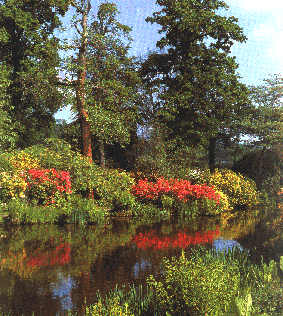
|
||||||||||||||||||||||||
Introduction |
Wildlife & Dawn Chorus |
Virginia Water |
The Copper Horse |
The Long Walk |
Queen Anne's Ride |
Frogmore Mausoleum |
Bears Rails |
Polo and Smiths Lawn |
Cranbourne Tower |
Other Activities |
Savill Garden |
Little House at Royal Lodge |
Rangers Gate |
The Valley Gardens |
The Totem Pole |
Blacknest Gate |
The Royal Pageant of The Horse - that never was! |
The Great Park Please advise Thamesweb if this link fails - thanks |
Windsor Great Park and the surrounding areas provide superb opportunities for horse riding. Permits are required to ride in the Great Park available upon application to: Tel: 01753 860222 |
William Menzies. Longman Green. 1864 |
Available NOW!
|
FURTHER RECOMMENDED READING: 'Royal Landscape,' The Gardens and Parks of Windsor, Jane Roberts, Yale University Press, 1997. This book contains a mass of information about the Parks, and is gloriously illustrated.
An Introduction to Windsor Great ParkTo the south of Windsor
is The Great Park extending over some 14,000 acres of which 8,000
acres are forest. 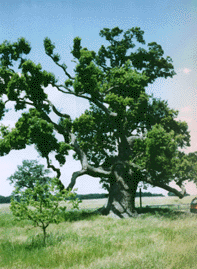 with a young oak sapling planted just a year or two ago (1998) The Park is very carefully managed, with
an eye for the very distant future, new plantings being undertaken
as and when necessary to replace old and diseased trees, which,
in the case of the oak especially, can date back 500 years and
more. In the 1700s there was a great demand for English oak for
the building of naval ships and the older oaks are not nearly
as common as they once were, but regular plantings over the centuries,
which continues to this day, will ensure that The Great Park
will remain an area of outstanding beauty throughout this Millennium. Wildlife and The Dawn ChorusThe Great Park offers splendid opportunities
for walking, horse riding or cycling and it is a naturalist's
paradise. Throughout the spring, at sun rise, the wide variety
of bird life makes the dawn chorus an exciting event to experience.
Recommended areas are around Smiths Lawn, Blacknest Gate, The
Valley Gardens and Virginia Water. 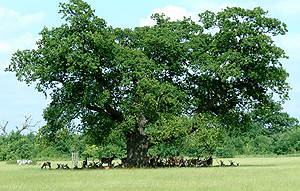 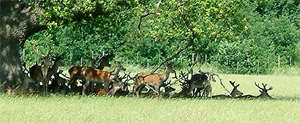 Off Queen Anne's Ride 24th June 2003 Virginia WaterThe beautiful Virginia Water, which is
a large man-made lake, dates back to1753 and forms a most efficient
drainage system for the Park. There is an early reference to
drainage of 'the Royal Park at Windsor' in the book 'James Brindley
and the Early Engineers', 1864, where Cornelius Vermuyden, a
Dutch engineer, was engaged to undertake the work. In 1621 he
had successfully stemmed a breach in the Thames embankment at
Dagenham, and subsequently installed drainage at Hatfield Level,
a royal chase on the borders of Yorkshire, at the invitation
of James I.
As to why the lake is known as Virginia Water is not certain. It is believed to be borrowed from the great State of Virginia, in America, which had been so called in honour of Queen Elizabeth. 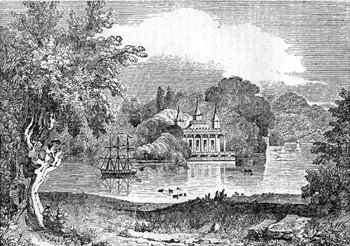
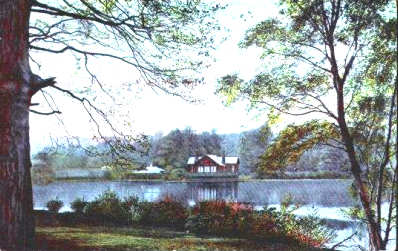 The Cascade, or Waterfall, is also notable. It is close by the A30 main road and constructed from stones brought from Bagshot Heath. They are rumoured to be the remains from a Saxon settlement. From the Cascade a stream runs through a glen and ultimately enters the Thames at Chertsey. By the side of the Cascade, immense stones are arranged to form a cavern known as 'The Robber's Cave'. 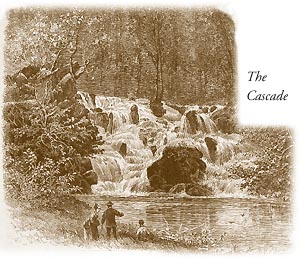 under the heading 'A Tour of Windsor'. The full article is available here
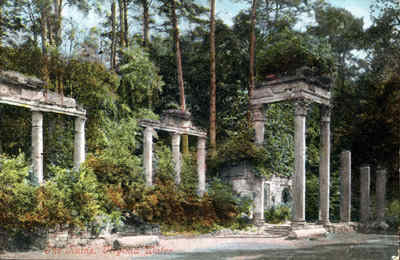 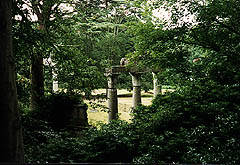 Virginia Water is about 7 miles in circumference, being around two miles long and one third of a mile wide at its widest point. Duke of Cumberland's Chinese Junk 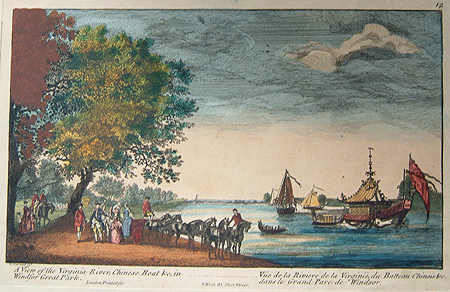 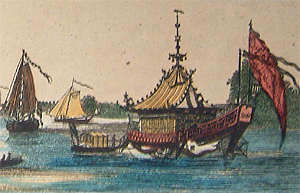 The images above are from a drawing c.
1754 by Thomas Sandby, 1721 - 1799, in the Royal Collection,
RL 14646. The 'Edward VII' or 'The Brig' 1904 - 1919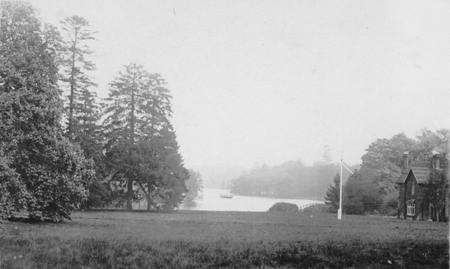 Hidden in the mists of the picture above is one of the last non-motorised boat to sail on Virginia Water. Named the Edward VII, she was a 10 gun brig, converted to scale from a 42' cutter at Sheerness Dockyard in 1904 and sailed to Brentford on the Thames before being brought to Virginia Water by road. The royal children, including The Prince of Wales, later Edward VIII, and the Duke of Kent, all enjoyed playing on her but she was scrapped in 1919 on the orders of the Admiralty when she was found to be infested extensively from dry rot. Requests to launch boats on Virginia Water were normally refused although Sandhurst cadets were allowed to practice rowing on the lake in 1919. Later the Duke of Kent and the Prince of Wales, along with their friends, were to use speed boats on Virginia Water in 1931 but after an accident or two, and concern that wading ashore would be unsafe due to the 'vegetable ooze' on the bottom, it was agreed that all boating should be stopped in 1936. Indeed Edward VIII ordered that all boats be dispersed to Portsmouth, Chatham and Dartmouth and that the Fishing Cottage, now in a very bad state of repair, be demolished. (Sources: South, Royal Lake and Roberts Royal Landscape) 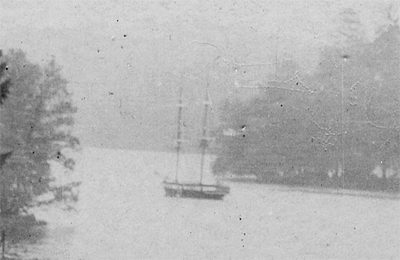 The Launch of the Frigate 'Adelaide' In May 1834 the frigate 'Adelaide' was launched on Virginia Water in the presence of several thousand Windsorians and Eton boys. A contemporary report from the Windsor Express of the day is reproduced here. TRAVELArriving by CarVisitors by car from Windsor may take either the Old Windsor road, or Ascot/Bracknell road out of Windsor and drive around to the south of Windsor Great Park where there is a choice of parking areas and park entrance gates, the main ones being along the A30 adjacent to The Wheatsheaf and Wentworth Golf Course. Walking and CyclingWalkers may enjoy an extended walk from The Long Walk, turning left at The Copper Horse, past Royal Lodge and Cumberland Lodge and onwards to Virginia Water via Smith's Lawn. Please note, cycling is not permitted on the Long Walk. Cyclists should take the road either to Old Windsor and follow the signs to Savill Gardens, or follow the cycle routes through the park, to the west of the Long Walk, or east through Old Windsor. Cycling in Windsor is planned as a future update to The Royal Windsor Web Site.
The Copper Horse and Snow Hill |
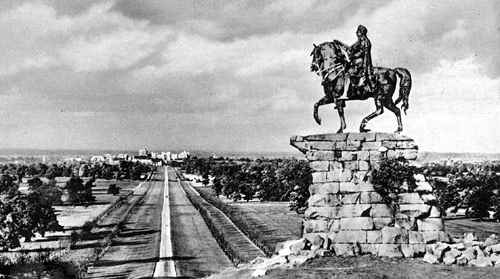 and the George IV gateway. shortly after the replanting of the Long Walk. |
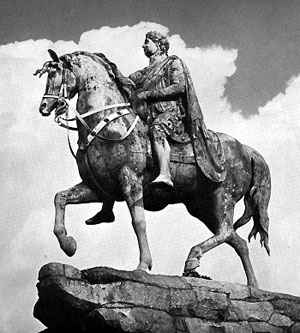 It is said that Henry VIII stood on Snow Hill awaiting news of Anne Boleyn's execution which was to be signalled by gunfire from The Round Tower. The Copper Horse, a statue of George III on horseback, was erected on Snow Hill by his son, George IV and created by Sir Richard Westmacott in the years 1824-1830. The statue is the source of a rumour that the sculptor hanged himself after realising he had forgotten the stirrups! As Sir Richard lived to a ripe old age the story is not founded in truth! George IV wanted the statue of his father to resemble that of Peter the Great in St Petersburgh, hence the massive base. Before the Copper Horse could be erected, it was damaged in transit when the cart carrying it broke down near Snow Hill, and a furnace was set up on the spot and repairs made to the damaged leg. There are superb views of the Castle from The Copper Horse along The Long Walk, another avenue similar to Queen Anne's Ride, some two miles long. Well worth a - long - walk! 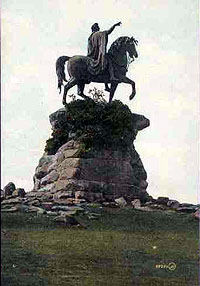 post cards that were sold at that time.
The Long WalkThe Long Walk has been moved to a story of its own. Please click here Queen Anne's Ride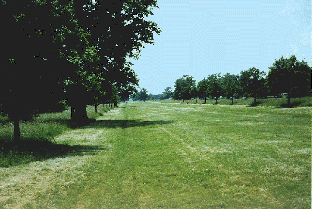 Queen Anne's Ride, dating from 1708, is
a grand avenue similar to The Long Walk, also three miles in
length, but unlike its more famous counterpart, it features only
a single row of trees on each side. It runs south-west towards
Ascot. In the 18th Century it was known as Queen's Walk, the
name changing during the nineteenth century.  looking towards Windsor Castle 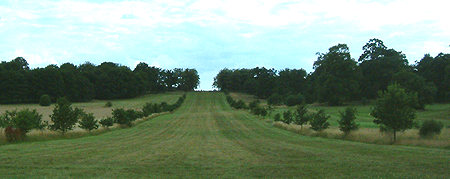 looking south west Rangers GateBeyond Queen Anne's Ride on the A332 road to Bracknell there lies Rangers Gate with Rangers Lodge beyond. Parking is normally possible opposite this gate with a pleasant walk over the hill towards The Village and through to the Copper Horse beyond.
Frogmore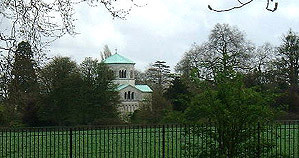 Please see Frogmore Mausoleum and Opening Times In the gardens of Frogmore House is the Royal Mausoleum where both Queen Victoria and Prince Albert are buried. The Mausoleum is easily seen from the Long Walk, on the eastern side. The Valley GardensThe Valley Gardens article has been moved to a page of its own. The Valley Gardens Bears RailsTo the east of the Park, near Old Windsor, is Bears Rails. 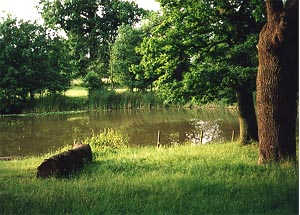 Smiths LawnThe history of Smiths Lawn deserves an
extensive article in its own right which we hope to prepare at
some point in the future. In the meantime we have found some
references and images which we hope are of interest. First, its
name. As with all these things it is impossible to be 100% certain,
but the name was first recorded as 'Smith's Lawn Plantation'
around 1748, a 'lawn' in this case being a glade or pasture in
a deer park. There is no mention of Smith's Lawn prior to 1748
but it could have been named after Thomas Smith, keeper at Manor
Lodge at the time of the Restoration. Some suggest it was named
after Bernard Smith, stud groom - an important position to a
Royal Family keen on horse-racing - between 1745 and 1765 but
these dates are a little late. 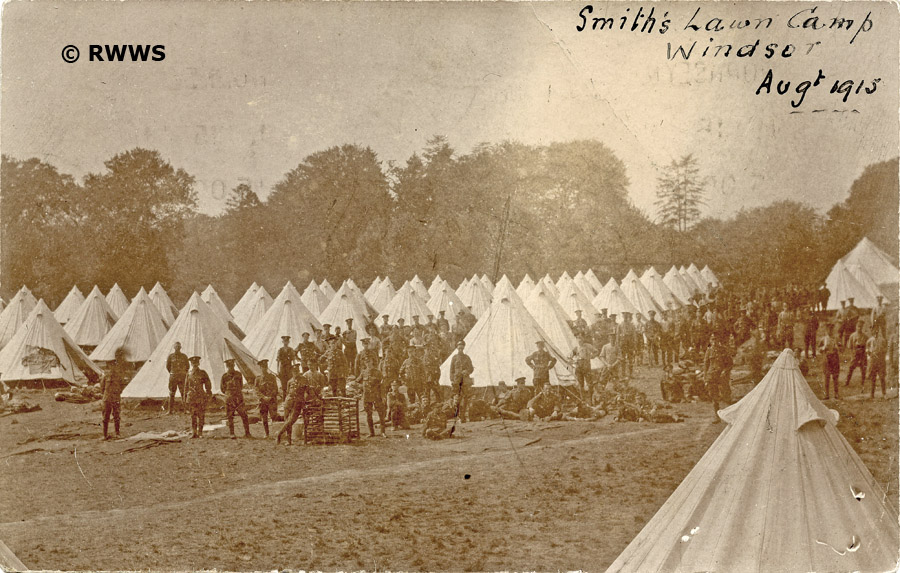 The picture above illustrates a military
camp on Smith's Lawn in 1915. It seems likely that the camp was
for training purposes before the troops set off for the 'front'
in northern France. PoloPolo is played most days on Smith's Lawn
during the summer. Teams from all over the country, and abroad,
even as far as Argentina, compete with their entourage of ponies.
Polo ponies are renowned for their agility, and makes for a game
of great speed and excitement. The balls are large and heavy,
and in the 1950s used to be made from wood although these days
they are plastic. The game is divided into time periods known
as 'chukkas'. Between chukkas the riders may take a few moments
to leave the field and change ponies. In the 1950s the spectators
were invited to walk onto the pitch during the intervals to 'tread
the divots', saving the groundsmen much work in restoring the
surface of the pitch after countless hooves had gouged great
holes in the turf. The Queen was often to be seen watching, as
was Princess Diana in more recent years. Both Prince Charles
and The Duke of Edinburgh were skilled players in their day.
Prince William and Prince Harry are also accomplished players
today. The Totem PoleThe Totem Pole article has a page of its own. The Totem Pole Cranbourne Tower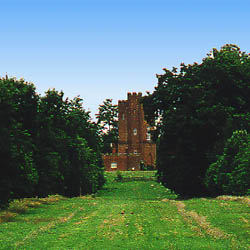 Cranbourne Tower is visible to the north
west of the A332, Windsor-Bracknell road, at the top of the hill
before the forested area, and has been greatly altered. It was
built by the Earl of Ranelagh in the reign of Charles II and
used to be known as Cranbourne Lodge. William, Duke of Cumberland,
subsequently occupied it and the last Royal personage to reside
in it was the Princess Charlotte, daughter of George IV. Part
of the building was pulled down and the Tower is all that remains. Other activities in the Great ParkThere is an area set aside to the north
of the A332 to Bracknell for both model aircraft and kite flying.
A popular hobby for many Windsorian children, flying takes place
at weekends and weekday evenings - weather permitting!
|

